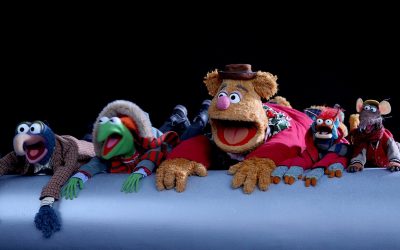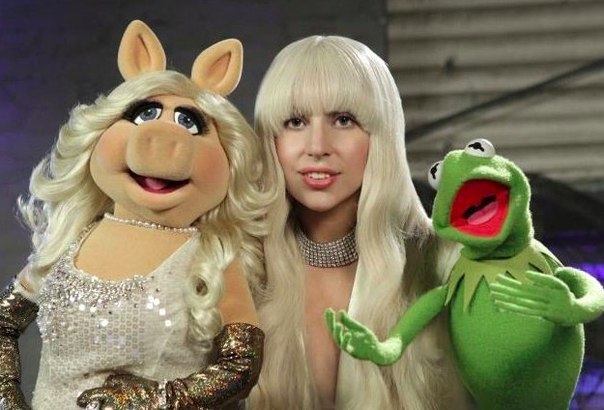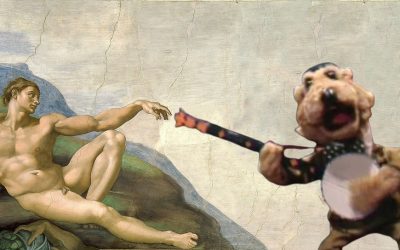 This is the first in a three-part series of articles in which Tough Pigs contributors take a look at The Dark Crystal.
This is the first in a three-part series of articles in which Tough Pigs contributors take a look at The Dark Crystal.
I first saw The Dark Crystal during what must have been its first network TV broadcast. I was already a Jim Henson fan, so I was inclined to be enchanted by whatever he had up his crazy creative sleeve. I was also a lot more easily impressed in those days. For example, my favorite show on TV at the time was a Scrubbing Bubbles commercial. Now here was this movie The Dark Crystal: it had cool-looking puppets, it was created by Jim Henson, and it included a character who could remove her eyeball. With this formidable combination, I assumed for years that it must be a great film.
On joining the online Henson fan community, however, I was surprised to discover that there were those who weren’t crazy about it. Reading the criticisms of the movie (such as the ones in this classic article by Tough Pigs founder Danny Horn), I had to concede that it was deeply flawed, so I changed my official position. The Dark Crystal was, in fact, stinky.
It’s now been years since I last saw the film, so I wanted to give it another look and make a definitive decision, as a mature, discriminating viewer, albeit one who owns some Bert underwear. So I sat down to screen the movie with fellow Muppet fan Michal (who had never seen it) and fellow Muppet fan Joe (who also hadn’t seen it in years). We poured ourselves a nice, cold glass of Podling essence, and stuck the thing in the VCR.
The question at hand: Is The Dark Crystal a masterpiece or a crapsterpiece? To ensure I was viewing the movie in the right state of mind, I invited my seven-year-old self to watch it with us, so I could get his less jaded take on things.
The film’s opening moments do not bode well. It begins with a static shot of the Skeksis’ ugly castle, as a narrator drones on drearily to fill us in on what’s been happening for the last thousand years. It was an “age of wonder,” he tells us, but all we see is a model of a decrepit old castle in serious need of an extreme makeover. This is followed by more narration over a shot of the Skeksis all standing around staring at the titular crystal. At this point, Seven-Year-Old Ryan is already getting restless. “How long is this movie?” he asks, adding, “Can we watch Thundercats after this?”
 The Skeksis, by the way, are U-G-L-Y. Seriously, they ain’t got no alibi — they’re ugly. But they’re supposed to be horrible villains, so it works for them. On the other end of the spectrum, we have those long-haired elderly gentlemen, the Mystics, whom we first see as they raise their voices in a ceremonial chorus of nine-part harmony. For some reason, Seven-Year-Old Ryan thinks this is absolutely hilarious. He laughs uproariously, then tries to imitate their call, although he doesn’t quite hit the same low notes, and ended up sounding more eunuch than Mystic.
The Skeksis, by the way, are U-G-L-Y. Seriously, they ain’t got no alibi — they’re ugly. But they’re supposed to be horrible villains, so it works for them. On the other end of the spectrum, we have those long-haired elderly gentlemen, the Mystics, whom we first see as they raise their voices in a ceremonial chorus of nine-part harmony. For some reason, Seven-Year-Old Ryan thinks this is absolutely hilarious. He laughs uproariously, then tries to imitate their call, although he doesn’t quite hit the same low notes, and ended up sounding more eunuch than Mystic.
Shortly after, we’re introduced to Jen, the Last Surviving Gelfling and our hero, who is about to embark on a very important journey to heal the crystal. Jen is just a little fellow, the kind of protagonist one expects to watch going through a character arc from weakling to warrior, learning all about courage and his own purpose along the way. But guess what? None of that happens.
Actually, there’s really just one problem with Jen: He’s boring, and he never does anything, and I don’t care about him. Okay, that’s more than one thing, but throughout the movie, Jen just kind of sits there and let things happen around him. He’s the most passive central character this side of Where’s Waldo. We never really get to know him, except for some inner monologues, in which we hear Jen thinking, “What am I doing here? Where am I supposed to go? Should I have packed a toothbrush?” Take the scene in which Aughra’s observatory (which, by the way, is a really awesome set) is attacked by Garthim, a roving gang of big mean beetles. Jen does not fight them off or attempt to protect Aughra, he just escapes… by falling out a window. As much as I like defenestration, it did not serve to make me like the guy.
I should note, however, that Seven-Year-Old Ryan doesn’t seem to mind. He likes Jen well enough, although I don’t think he’d ever dress as him for Halloween. And Seven-Year-Old Ryan remarks that “Jen” is a girl’s name, so he probably got made fun of as a kid. I don’t point out to him that there were no other Gelflings around to bully Jen because they had all been slaughtered by monsters.
Then there’s a scene set in a marshy forest, a forest full of fanciful flora, fantastic fauna, and imagination. Dang, I wish “imagination” started with an “f”… I had some really great alliteration going there. Anyway, I think this is my favorite sequence of the film, even though it has little to do with the story. It’s a plethora of dreamed-up critters that exist simply to show off what the brand spanking new Creature Shop could do, and I love it. Seven-Year-Old Ryan digs it too. He especially likes “the part where the big monster guy eats the little guy.”
The forest is also where Jen and we encounter the film’s female lead. As a character, she doesn’t fare much better than Jen. Kira, the other Last Surviving Gelfling, is more of a device than a character, what with her wings and her Dr. Doolittle-style animal chat skills, and her ability to hotwire a Landstrider. Seven-Year-Old Ryan, by the way, loves the Landstriders, and expresses a wish that they were real animals so he could see them at the zoo.
We watch as Kira takes Jen to a high-energy celebration at the village of her adoptive family, the Podlings. Ain’t no party like a Podling party, ’cause a Podling party don’t stop! That is, until the Garthim destroy the village and enslave everyone. (Which really puts a damper on the whole party… no one’s in the mood for Pin the Tail on the Nebri anymore) Seven-Year-Old Ryan finds the Podlings funny, and asks me to make sure everyone knows he wasn’t scared during the Garthim attack.
Then a bunch of other stuff happens… I don’t remember the sequence of events exactly, but it probably involves the Chamberlain Skeksis squealing and some characters talking about the Prophecy over and over again. There really oughtta be a Dark Crystal drinking game, and I’d be surprised if there’s not one out there somewhere.
I should mention Aughra, the sassy old broad who gives Jen the shard he needs to heal the crystal. She has more personality in her free-range eyeball than Jen and Kira have in their entire elfin bodies, and I wouldn’t have minded seeing more of her.
And I have nothing bad to say about Kira’s pet fuzzball Fizzgig, who is clearly the R2-D2 of The Dark Crystal — he’s a loyal companion to the main characters, the audience can’t understand what he says, and he jumps in at an important juncture to save the day. Fizzgig, a living Koosh ball, is also the most Muppetlike of the film’s characters, which is perhaps not unrelated to his being the most lovable. Seven-Year-Old Ryan is fascinated by Aughra, and likes Fizzgig, who reminds him of his friend Chad’s dog, whose name is Crackers.
Meanwhile, some other boring stuff happens, and then Jen and Kira heal the crystal, la de da de da. The End, and everyone’s happy. But here’s a question: At the end of the movie, when the Skeksis and Mytics are amalgamated to become the UrSkeks, the UrSkek spokesman reveals that they were the ones who broke the crystal in the first place. Why? What did they think was going to happen? Were they trying to make some money by selling crystal paperweights or earrings, or shard toothpicks? I realize that all we need to know at the start of the film is that the crystal done got broke, but on this viewing I kept wondering who thought slicing the crystal would be a good idea. And although it’s great that the crystal is healed, what happens if someone accidentally chips or scrapes it? I suppose everyone’s SOL for another 1000 years.
I once explained my position on The Dark Crystal by saying it would best be viewed with the dialogue removed, and after a careful re-viewing I stand by that. The musical score is great, the visuals are striking, the technical aspects are amazing, and I really have to hand it to Jim Henson, character designer Brian Froud, and their whole crew for making some seriously ugly puppets. When you create all your actors from scratch, it would be easy to make them all cute and licensable, but these creatures really look like… creatures.
Ultimately, though, that doesn’t make up for the shallow story and uninteresting characters. Seven-Year-Old Ryan, on the other hand, said the movie was really cool, although when I asked him whether he thought it was better than Labyrinth, he said no. When I asked him if it was better than the Jim Henson Company’s fantasy fim Mirrormask, he reminded me that he’s from 1988 and Mirrormask hasn’t been made yet.
As for me, I’d have to rate the movie about a half-star higher today than I would have a week ago, but it’s still not A Good Movie. Have you ever read an old fairy tale from, like, 15th century Europe? They’re full of magic and fantastic creatures and epic journeys, but the storytelling is simplistic, and by the end of the proceedings nobody has changed or learned anything. The Dark Crystal is like that. It’s a beautiful, ornate, hand-carved frame, but the painting inside is just a bunch of stick figures.
Say, that was a pretty good metaphor. I wonder if I just came up with that, or ripped it off from somewhere else?
In the end, Seven-Year-Old Ryan and Contemporary Ryan agree whole-heartedly on one thing: Aughra’s detachable eye is rad.
Click here to discuss this article on the Tough Pigs forum! And come back Wednesday to read another Tough Pigs contributor’s take on The Dark Crystal!



